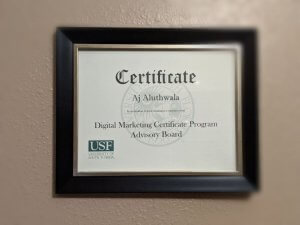
15 Tips for Crafting Email Subject Lines That Drive Sky-High Open Rates
E-mail marketing should be part of any business’s marketing arsenal. Unfortunately, in the fast-paced digital age, standing out in a crowded inbox is no easy feat. Your email subject line is your golden ticket to capturing the attention of your recipients. Crafting an irresistible subject line is a fine art, and in this article, we’re going to share the tips and strategies that will help you create subject lines that not only get noticed but also result in massive open rates.
Take a look at the Top 10 Tips For Sky Rocketing Your Open Rates infographic below or read past it for more details and 5 extra tips!

1.Keep It Short and Sweet
Short and sweet subject lines are effective because they get straight to the point, making it easier for your recipients to understand the email’s content at a glance. This is particularly important in a world where we’re inundated with information and have limited time to decide which emails to open. Subject lines exceeding 60 characters may get cut off on certain email clients, causing your recipients to miss important information.
For example, a concise subject line like “Exclusive Savings: 30% Off” is more likely to capture the reader’s attention than a longer, more convoluted version such as “Don’t Miss Out on Our Exclusive 30% Discount for You!” Short subject lines are also easier to scan, which is beneficial for those quickly scrolling through their inbox on mobile devices.
2.Use Action Words and Verbs
Using action words and verbs in your subject lines is crucial because it compels your recipients to take immediate action. Verbs such as “discover,” “grab,” “save,” and “hurry” create a sense of urgency and motivate readers to open your email. This sense of urgency is essential for engaging your audience and encouraging them to act promptly.
For instance, a subject line like “Hurry, Limited-Time Offer Inside” creates a sense of urgency by using the verb “hurry” and the phrase “Limited-Time Offer.” It communicates the need for immediate action, making it more likely for recipients to open the email to see what they might miss out on. Action-oriented subject lines instill a sense of curiosity and excitement, driving open rates and click-through rates.
3.Personalize Where Possible
Personalization is a powerful tool in email marketing because it allows you to address your recipients on an individual level. Using the recipient’s name in the subject line, as in “Hey [Recipient’s Name], Ready to Discover Your Secret Perk?” helps establish a connection between you and the recipient. It conveys that you’ve tailored the message specifically for them, which can result in a higher likelihood of the email being opened.
Modern email marketing platforms make personalization easy by enabling you to insert dynamic fields for the recipient’s name. Beyond using their name, you can also personalize subject lines based on their purchase history, location, or past interactions with your emails. This level of personalization goes a long way in making your recipients feel valued and understood, ultimately leading to increased open rates.
For example, a travel agency might use personalization to send an email with the subject line “Hey Sarah, Your Next Adventure Awaits!” to a customer who has previously booked trips with them. This not only addresses the recipient by name but also uses their past engagement data to tailor the message to their interests.
4.Create a Sense of Curiosity
Curiosity is a powerful human emotion that drives us to seek answers and satisfy our inquisitiveness. In the context of email subject lines, creating curiosity can be a highly effective strategy to increase open rates. When recipients see a subject line that hints at an intriguing but undisclosed message, they are naturally inclined to open the email to satisfy their curiosity. However, it’s crucial to strike a balance – you want to generate interest without misleading your audience. For example, a subject line like “Unveil the Mystery Behind Our Upcoming Event” teases something exciting without revealing too much. This approach encourages recipients to click and explore further, which can lead to higher open rates.
5.Use Emojis Sparingly
Emojis have become a part of our digital communication and can be an asset in email subject lines. When used correctly and sparingly, emojis can add a touch of personality and visual appeal to your message. They can make your subject line stand out in a sea of text-based emails, capturing the recipient’s attention. Emojis also help convey emotions or context that words alone may not fully express. For instance, a heart emoji ❤️ in a subject line like “Show Your Loved Ones You Care ❤️” adds warmth and emotional appeal.
However, it’s important to use emojis in moderation, ensuring that they are relevant to the email’s content and the overall tone of your brand. Overusing emojis can make your emails appear unprofessional or cluttered, which may have the opposite effect and deter recipients from opening your message.
6.Test and Experiment
A/B testing or split testing is a fundamental practice in email marketing to refine your subject line strategy. It involves sending two or more versions of an email with different subject lines to a subset of your subscribers and then analyzing the performance of each. By conducting A/B tests, you can uncover valuable insights into what resonates most with your specific audience. For example, you can test variations of your subject line, like “Exclusive Offer: Save 30% on Your Next Purchase” against “Last Chance: Save Big with 30% Off.” After analyzing the results, you might find that the second subject line, emphasizing urgency, significantly outperforms the first one in terms of open rates. This data-driven approach allows you to continually optimize your subject lines and tailor them to your audience’s preferences, leading to higher engagement and better results.
7.Convey Value and Benefit
Your email subject line should succinctly communicate the value and benefit that recipients will gain by opening and engaging with your email. In today’s fast-paced digital world, people are often overwhelmed by a constant influx of emails. To stand out, your subject line should make it abundantly clear what’s in it for the recipient. For instance, “Boost Your Productivity: 5 Proven Strategies for Success” provides a clear value proposition – the reader can expect to gain valuable insights on improving their productivity.
The benefit is the knowledge and strategies that can lead to enhanced success. This approach ensures that your audience understands the relevance and significance of your email content, increasing the likelihood of them opening and engaging with it. The key here is to align the value with your audience’s needs and interests. Understanding your target demographic and tailoring your subject lines accordingly is crucial to success in this regard.
8.Avoid Spammy Words and Capitalization
Avoiding spammy words and excessive capitalization in your subject lines is vital to ensuring your emails reach the recipient’s inbox and don’t get caught in spam filters. Spammy words like “free,” “win,” and excessive use of capital letters can trigger email providers’ spam algorithms. When your email is flagged as spam, it’s less likely to land in the primary inbox and more likely to be relegated to the spam folder, where it might go unnoticed or be deleted without being read. Therefore, it’s important to craft subject lines that are professional and free from suspicious or aggressive language. Instead of using “Win a Free Vacation!” which may trigger spam filters, a more subtle approach like “Explore Our Vacation Giveaway” can be equally enticing without raising red flags. Maintaining a clean and respectful tone in your subject lines is not only an ethical practice but also a critical aspect of ensuring your emails reach your intended audience.
9.Harness the Power of FOMO
Creating a sense of urgency and the fear of missing out (FOMO) in your subject lines is a proven tactic for boosting open rates. FOMO taps into people’s innate desire to be part of something exclusive and not miss out on valuable opportunities. Subject lines that convey a limited-time offer or imminent deadline can generate a sense of urgency that compels recipients to open the email promptly. For instance, a subject line like “Last Day to Claim Your Exclusive Discount” implies that the opportunity is about to slip away, driving recipients to take immediate action.
The key is to ensure that your FOMO-based subject lines are backed by genuine offers or deadlines, as misleading your audience can erode trust and damage your email marketing efforts. The fear of missing out is a powerful psychological trigger that motivates readers to act swiftly, leading to higher open rates and increased engagement.
10.Segment Your Email List
Segmentation is a practice that involves dividing your email list into smaller, more targeted groups based on specific criteria such as demographics, purchase history, or engagement level. This strategy enables you to send highly relevant and personalized emails to each segment of your audience. When it comes to subject lines, segmentation allows you to tailor them to the unique interests and needs of each group. For instance, if you run an e-commerce store, you might have one segment of customers who regularly purchase clothing and another segment who are frequent buyers of electronics.
Crafting subject lines like “Exclusive Fashion Deals for Style Enthusiasts” and “Hot Electronics Savings for Tech Lovers” allows you to speak directly to each group’s preferences, making the emails more appealing. By delivering content that resonates with their interests, you significantly increase the likelihood of your emails being opened and acted upon. Segmenting your email list can be a time-consuming process, but the rewards in terms of open rates and overall engagement make it well worth the effort. It also showcases that you understand and value the diversity of your audience, building trust and loyalty over time.
11.Monitor and Analyze Metrics
Regularly monitoring and analyzing email metrics is a fundamental aspect of optimizing your email marketing strategy, including your subject lines. Metrics like open rates, click-through rates, and conversion rates provide valuable insights into the effectiveness of your subject lines. By tracking the performance of different subject lines over time, you can identify trends and patterns that help you understand what’s working and what’s not. For example, suppose you discover that subject lines emphasizing discounts or time-limited offers consistently result in higher open rates. In that case, you can adjust your email strategy to include more of these elements.
Analyzing metrics also allows you to perform deeper dives into the data, understanding how different segments of your audience respond to specific subject lines and content. By continuously refining your subject lines based on the insights gathered from metrics, you can ensure your emails are more engaging and relevant to your audience, leading to higher open rates and improved overall email marketing performance.
12.Use Social Proof
Social proof is a psychological phenomenon that relies on people’s tendency to look to others for guidance and validation. It’s a powerful persuasive tool in marketing, and it can also be effectively integrated into your subject lines. When you mention positive reviews, testimonials, endorsements, or the number of satisfied customers in your subject line, you’re providing proof that others have found value in your products or services. For instance, a subject line like “Join 10,000 Satisfied Customers – See Why They Love Us!” conveys that your brand has a substantial customer base, and those customers have had positive experiences with your offerings. This not only adds credibility to your message but also encourages recipients to open the email to discover what others are saying about your brand. It’s essential to ensure that any social proof mentioned in your subject lines is genuine and relevant to your audience. Misleading claims or fabricated endorsements can damage your reputation and trustworthiness.
13.Leverage Listicle Subject Lines
The listicle format, which presents content in a numbered or bulleted list, is popular and easily digestible. When this format is used in subject lines, it not only conveys a sense of structure and clarity but also suggests that the email contains valuable and organized information. For instance, a subject line like “5 Tips to Transform Your Home Office Setup” communicates that the email will offer practical and actionable advice in a clear, structured format. Recipients appreciate the simplicity and organization that listicles provide, making them more inclined to open and engage with the email content. Keep in mind that the content within the email should indeed match the listicle format, delivering on the promise made in the subject line. This consistency ensures that your emails not only get opened but also provide a positive user experience, leading to better engagement and trust with your audience.
14.Time It Right
The timing of your email sends can have a significant impact on open rates. Different audiences may have varying levels of receptiveness at specific times and on specific days. For example, an audience predominantly made up of office workers might be more likely to check their emails in the morning or during lunch breaks. In contrast, a younger demographic might be more active in the evening. By experimenting with different sending times and days and analyzing the results, you can pinpoint when your audience is most receptive to your emails. For instance, if you discover that a subject line like “Morning Inspiration: Start Your Day with Our Latest Offer” generates higher open rates when sent in the early morning, you can schedule your emails accordingly. Timing your emails right can significantly enhance their visibility and impact, as they are more likely to be at the top of the recipient’s inbox when they check their email.
15.Let AI Do The Heavy Lifting
Finally, you don’t necessarily have to do the writing yourself. Leverage tools like ChatGPT, Google Bard and Jasper to have them generate captivating subject lines that drive open rates. The trick for this is to ensure that the prompt you enter is both detailed enough and has context to the content of your mail so the resulting subject line is relevant and engaging. The more specific you are with these tools, the better the end result will be.
Additionally, search in Google for E-Mail Subject Line Generators, there are several free and paid tools that you can use to get started.
Remember, while you may not get the perfect output from these tools, they can be a great starting point from which to apply these tips to finetune and get the perfect subject line to skyrocket your open rates.
Don’t forget that while subject lines are critical for getting your emails opened, the content within your emails must also be valuable and relevant to keep your audience engaged and satisfied.
By paying close attention to these strategies and using them effectively in your email marketing campaigns, you can craft subject lines that drive high open rates and increase the overall success of your email marketing efforts. Remember, not all the tips would apply to a single subject line, it’s highly dependent on the goal and the content of the email. As such, mix and match tips to optimize your subject lines and use A/B testing to see which ones get the best open rates.
Now, let’s take a look at why some of these example subject lines work:
“🎁 John, Exclusive Savings Inside: Last Chance to Grab 30% Off!”
- This subject line is short and sweet, with only 50 characters.
- It uses an emoji to add visual appeal and grab attention.
- The phrase “Last Chance” creates a sense of urgency and FOMO.
- It clearly conveys the value and benefit of saving 30%.
- This subject line incorporates personalization by addressing the recipient by name.
“Hey Jack, Ready to Discover Your Secret Perk?”
- This subject line incorporates personalization by addressing the recipient by name.
- It uses the verb “discover” to encourage action.
- The phrase “Secret Perk” piques curiosity and encourages recipients to open the email to find out more.
“Boost Your Productivity: 5 Proven Strategies for Success”
- This subject line follows a listicle format, which people find appealing.
- It conveys value by promising “5 Proven Strategies.”
- The use of “Boost Your Productivity” clearly communicates the benefit.
“Unlock VIP Access: Limited Spots Available for Early Birds 🌟”
- This subject line leverages FOMO with “Limited Spots Available.”
- It uses an emoji for added visual appeal.
- The phrase “VIP Access” suggests exclusivity and value.
“Rave Reviews Inside: See What Our Happy Customers Are Saying”
- This subject line incorporates social proof by mentioning “Rave Reviews.”
- It conveys value by suggesting that recipients can see what happy customers are saying.
- The use of “See What Our Happy Customers Are Saying” creates curiosity and encourages opens.

 Previous Post
Previous Post Next Post
Next Post


